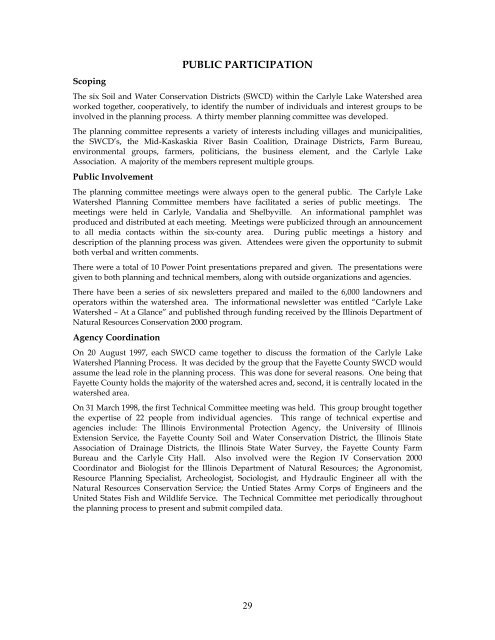Carlyle Lake Final Plan.pdf - Fayette County Soil & Water ...
Carlyle Lake Final Plan.pdf - Fayette County Soil & Water ...
Carlyle Lake Final Plan.pdf - Fayette County Soil & Water ...
You also want an ePaper? Increase the reach of your titles
YUMPU automatically turns print PDFs into web optimized ePapers that Google loves.
Scoping<br />
PUBLIC PARTICIPATION<br />
The six <strong>Soil</strong> and <strong>Water</strong> Conservation Districts (SWCD) within the <strong>Carlyle</strong> <strong>Lake</strong> <strong>Water</strong>shed area<br />
worked together, cooperatively, to identify the number of individuals and interest groups to be<br />
involved in the planning process. A thirty member planning committee was developed.<br />
The planning committee represents a variety of interests including villages and municipalities,<br />
the SWCD’s, the Mid-Kaskaskia River Basin Coalition, Drainage Districts, Farm Bureau,<br />
environmental groups, farmers, politicians, the business element, and the <strong>Carlyle</strong> <strong>Lake</strong><br />
Association. A majority of the members represent multiple groups.<br />
Public Involvement<br />
The planning committee meetings were always open to the general public. The <strong>Carlyle</strong> <strong>Lake</strong><br />
<strong>Water</strong>shed <strong>Plan</strong>ning Committee members have facilitated a series of public meetings. The<br />
meetings were held in <strong>Carlyle</strong>, Vandalia and Shelbyville. An informational pamphlet was<br />
produced and distributed at each meeting. Meetings were publicized through an announcement<br />
to all media contacts within the six-county area. During public meetings a history and<br />
description of the planning process was given. Attendees were given the opportunity to submit<br />
both verbal and written comments.<br />
There were a total of 10 Power Point presentations prepared and given. The presentations were<br />
given to both planning and technical members, along with outside organizations and agencies.<br />
There have been a series of six newsletters prepared and mailed to the 6,000 landowners and<br />
operators within the watershed area. The informational newsletter was entitled “<strong>Carlyle</strong> <strong>Lake</strong><br />
<strong>Water</strong>shed – At a Glance” and published through funding received by the Illinois Department of<br />
Natural Resources Conservation 2000 program.<br />
Agency Coordination<br />
On 20 August 1997, each SWCD came together to discuss the formation of the <strong>Carlyle</strong> <strong>Lake</strong><br />
<strong>Water</strong>shed <strong>Plan</strong>ning Process. It was decided by the group that the <strong>Fayette</strong> <strong>County</strong> SWCD would<br />
assume the lead role in the planning process. This was done for several reasons. One being that<br />
<strong>Fayette</strong> <strong>County</strong> holds the majority of the watershed acres and, second, it is centrally located in the<br />
watershed area.<br />
On 31 March 1998, the first Technical Committee meeting was held. This group brought together<br />
the expertise of 22 people from individual agencies. This range of technical expertise and<br />
agencies include: The Illinois Environmental Protection Agency, the University of Illinois<br />
Extension Service, the <strong>Fayette</strong> <strong>County</strong> <strong>Soil</strong> and <strong>Water</strong> Conservation District, the Illinois State<br />
Association of Drainage Districts, the Illinois State <strong>Water</strong> Survey, the <strong>Fayette</strong> <strong>County</strong> Farm<br />
Bureau and the <strong>Carlyle</strong> City Hall. Also involved were the Region IV Conservation 2000<br />
Coordinator and Biologist for the Illinois Department of Natural Resources; the Agronomist,<br />
Resource <strong>Plan</strong>ning Specialist, Archeologist, Sociologist, and Hydraulic Engineer all with the<br />
Natural Resources Conservation Service; the Untied States Army Corps of Engineers and the<br />
United States Fish and Wildlife Service. The Technical Committee met periodically throughout<br />
the planning process to present and submit compiled data.<br />
29



